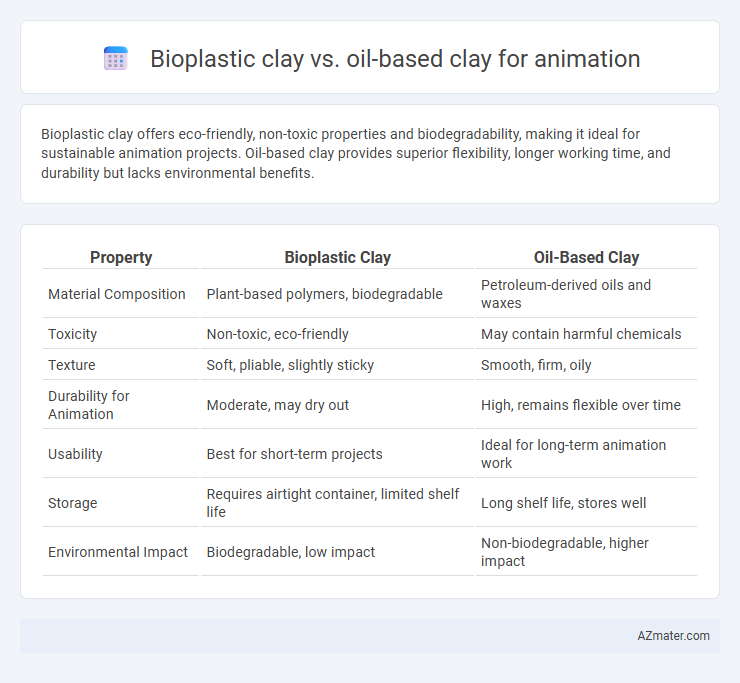Bioplastic clay offers eco-friendly, non-toxic properties and biodegradability, making it ideal for sustainable animation projects. Oil-based clay provides superior flexibility, longer working time, and durability but lacks environmental benefits.
Table of Comparison
| Property | Bioplastic Clay | Oil-Based Clay |
|---|---|---|
| Material Composition | Plant-based polymers, biodegradable | Petroleum-derived oils and waxes |
| Toxicity | Non-toxic, eco-friendly | May contain harmful chemicals |
| Texture | Soft, pliable, slightly sticky | Smooth, firm, oily |
| Durability for Animation | Moderate, may dry out | High, remains flexible over time |
| Usability | Best for short-term projects | Ideal for long-term animation work |
| Storage | Requires airtight container, limited shelf life | Long shelf life, stores well |
| Environmental Impact | Biodegradable, low impact | Non-biodegradable, higher impact |
Introduction: Understanding Animation Clays
Bioplastic clay, derived from renewable plant-based materials, offers a non-toxic and eco-friendly alternative to traditional oil-based clay in animation. Oil-based clay remains pliable for extended periods without drying out but contains synthetic oils that can be harmful to the environment. Understanding the material properties of bioplastic versus oil-based clay is essential for animators seeking sustainable options without compromising on malleability and texture for stop-motion projects.
What is Bioplastic Clay?
Bioplastic clay is a sustainable modeling material derived from natural polymers like cornstarch or cellulose, offering an eco-friendly alternative to traditional oil-based clay used in animation. It is non-toxic, biodegradable, and often has a softer texture, making it easier to mold for intricate stop-motion characters and sets. Unlike oil-based clay, bioplastic clay does not emit strong odors and is less likely to grease or stain, enhancing both safety and cleanliness in animation studios.
What is Oil-Based Clay?
Oil-based clay, commonly known as plasticine, is a pliable modeling material used extensively in stop-motion animation due to its non-drying, reusable properties. Unlike bioplastic clay, oil-based clay remains soft over time, allowing animators to make continuous adjustments without cracking or hardening. Its composition typically includes mineral oils and waxes, providing flexibility and durability essential for detailed character modeling and seamless frame-by-frame animation.
Key Differences Between Bioplastic and Oil-Based Clays
Bioplastic clay is biodegradable, non-toxic, and often made from renewable resources such as cornstarch, offering a more environmentally friendly option compared to oil-based clay, which contains petroleum derivatives and is less biodegradable. Oil-based clay, favored for its pliability and long-lasting consistency, remains soft over time and is ideal for detailed animation modeling, whereas bioplastic clay tends to dry out faster and may become brittle. The key differences lie in their composition, environmental impact, and longevity, making bioplastic clay suitable for eco-conscious projects and oil-based clay preferred for professional stop-motion animation requiring durability.
Workability and Handling in Animation
Bioplastic clay offers exceptional workability due to its pliable texture and easy reshaping capabilities, making it ideal for detailed animation models that require frequent adjustments. In contrast, oil-based clay maintains a consistent softness over extended periods but can be greasier, which may affect fine handling and intricate sculpting. Animators benefit from bioplastic clay's cleaner handling and less residue, enhancing precision during complex character animations.
Durability and Moldability Comparison
Bioplastic clay offers superior moldability due to its softer texture and flexibility, making it ideal for intricate animation details and smooth transitions between frames. Oil-based clay, known for its exceptional durability, resists drying out and cracking, allowing prolonged use without degradation in shape or quality, which is crucial for long-term stop-motion projects. While bioplastic clay excels in ease of manipulation, oil-based clay provides a stable medium that maintains consistent form during repetitive handling and repositioning.
Environmental Impact and Sustainability
Bioplastic clay, derived from renewable resources such as cornstarch or natural resins, offers a significantly lower environmental impact compared to traditional oil-based clay, which relies on non-renewable petroleum products. The biodegradability of bioplastic clay ensures reduced landfill accumulation and decreased toxic residues, promoting sustainability in animation studios focused on eco-friendly production. In contrast, oil-based clay often persists in ecosystems longer and requires energy-intensive manufacturing, making it a less sustainable choice for environmentally conscious animators.
Suitability for Stop-Motion Animation
Bioplastic clay offers superior flexibility and non-toxicity, making it ideal for long hours of stop-motion animation due to its reduced cracking and ease of sculpting fine details. Oil-based clay, while durable and reusable, can be heavier and less stable under constant handling, posing challenges for intricate frame-by-frame movement. Stop-motion animators prioritize bioplastic clay for its ability to maintain shape without drying out, ensuring consistent performance throughout production.
Cost and Availability for Animators
Bioplastic clay generally costs more than oil-based clay due to its eco-friendly composition and limited production scale but offers sustainable benefits for animators prioritizing environmental impact. Oil-based clay remains widely available, affordable, and preferred for its ease of use and longer working time, making it a cost-effective choice for both amateur and professional animation studios. Accessibility to oil-based clay in various markets ensures consistent supply, while bioplastic clay may require special sourcing, impacting production budgets.
Choosing the Right Clay for Your Animation Project
Bioplastic clay offers eco-friendly properties and easier cleanup, making it ideal for animators prioritizing sustainability and quick adjustments. Oil-based clay provides superior malleability and durability, suitable for detailed sculpting and long-term use in stop-motion animation. Selecting the right clay depends on project requirements such as environmental impact, sculpting complexity, and animation style.

Infographic: Bioplastic clay vs Oil-based clay for Animation
 azmater.com
azmater.com